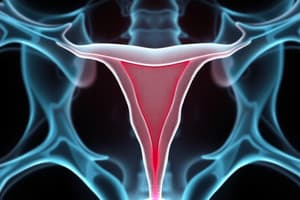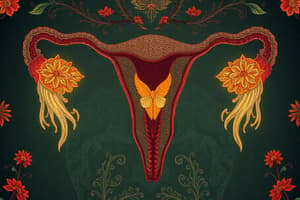Podcast
Questions and Answers
Where does fertilization typically occur?
Where does fertilization typically occur?
- Cervix
- Ovary
- Uterus
- Fallopian tubes (correct)
What initiates the development of the embryo after fertilization?
What initiates the development of the embryo after fertilization?
- The implantation into the uterine wall
- The differentiation of cells
- The growth of the placenta
- The fusion of sperm with the ovum (correct)
Which statement describes a crucial aspect of early embryonic development?
Which statement describes a crucial aspect of early embryonic development?
- The embryo does not require oxygen until birth
- Cell division only occurs after implantation
- Differentiation of cells is not necessary
- Early phases are highly vulnerable to external influences (correct)
What hormone-related process occurs during pregnancy?
What hormone-related process occurs during pregnancy?
How long does the pregnancy period typically last?
How long does the pregnancy period typically last?
What is a significant benefit of genetic variation in offspring?
What is a significant benefit of genetic variation in offspring?
Which of the following stages marks a significant phase of development after birth?
Which of the following stages marks a significant phase of development after birth?
What role does the placenta play during fetal development?
What role does the placenta play during fetal development?
What is the primary function of the male reproductive system?
What is the primary function of the male reproductive system?
Which organ is responsible for the production of eggs in females?
Which organ is responsible for the production of eggs in females?
What is the process called in males that produces sperm?
What is the process called in males that produces sperm?
During which stage of reproduction does fertilization occur?
During which stage of reproduction does fertilization occur?
Which hormone is primarily responsible for regulating male reproductive functions?
Which hormone is primarily responsible for regulating male reproductive functions?
What role do the accessory glands play in the male reproductive system?
What role do the accessory glands play in the male reproductive system?
What is the primary purpose of the uterus in the female reproductive system?
What is the primary purpose of the uterus in the female reproductive system?
What distinguishes oogenesis from spermatogenesis?
What distinguishes oogenesis from spermatogenesis?
Flashcards
Fertilization
Fertilization
The process where a sperm cell penetrates and fuses with an egg cell, marking the beginning of a new organism.
Zygote
Zygote
The first cell formed after fertilization, containing the complete genetic information from both parents.
Embryo
Embryo
The developing organism from fertilization to birth, undergoing rapid growth and differentiation.
Implantation
Implantation
Signup and view all the flashcards
Placenta
Placenta
Signup and view all the flashcards
Pregnancy
Pregnancy
Signup and view all the flashcards
Labor
Labor
Signup and view all the flashcards
Genetic Variation
Genetic Variation
Signup and view all the flashcards
What is the primary process of human sexual reproduction?
What is the primary process of human sexual reproduction?
Signup and view all the flashcards
What are the key components of the male reproductive system?
What are the key components of the male reproductive system?
Signup and view all the flashcards
What is the process of sperm production called?
What is the process of sperm production called?
Signup and view all the flashcards
What organs are involved in the female reproductive system?
What organs are involved in the female reproductive system?
Signup and view all the flashcards
Define gametogenesis and explain its key aspects.
Define gametogenesis and explain its key aspects.
Signup and view all the flashcards
What is the process of egg production called?
What is the process of egg production called?
Signup and view all the flashcards
What is the crucial event that marks the beginning of human development?
What is the crucial event that marks the beginning of human development?
Signup and view all the flashcards
Explain the key stages of fertilization.
Explain the key stages of fertilization.
Signup and view all the flashcards
Study Notes
Introduction to Sexual Reproduction in Humans
- Sexual reproduction in humans combines sperm from the male and an ovum (egg) from the female.
- This fusion forms a zygote, developing into a new individual.
- Fertilization occurs when sperm penetrates the ovum's protective layers, initiating development.
- Genetic diversity is essential, as it combines genetic material from both parents.
Male Reproductive System
- The male system produces sperm and delivers it to the female tract.
- Key organs include testes, epididymis, vas deferens, seminal vesicles, prostate gland, and urethra.
- Testes produce sperm through spermatogenesis.
- Sperm matures and stores in the epididymis.
- The vas deferens carries sperm to the urethra.
- Accessory glands (seminal vesicles, prostate) produce fluids to nourish and protect sperm, forming semen.
- The urethra is a common pathway for urine and semen.
- Hormones like testosterone control male reproductive functions.
Female Reproductive System
- The female system produces ova (eggs), receives sperm, supports fertilization, and nurtures the embryo.
- Key organs include ovaries, fallopian tubes, uterus, cervix, and vagina.
- Ovaries produce ova and hormones like estrogen and progesterone.
- These hormones regulate the menstrual cycle.
- Ova travel through fallopian tubes, where fertilization may occur.
- The uterus provides a site for a fertilized egg to implant and develop.
- The cervix controls access to the uterus, opening during birth, and closing to prevent infection during pregnancy.
- The vagina receives sperm and is the birth canal.
Gametogenesis
- Gametogenesis creates gametes (sperm and ova).
- Males produce millions of sperm continuously throughout their lives through spermatogenesis.
- Females produce a limited number of ova, releasing one mature ovum per menstrual cycle through oogenesis.
- Hormones regulate gamete production and other bodily functions.
Fertilization
- Fertilization is the union of sperm and ovum.
- It usually occurs in fallopian tubes.
- Sperm must penetrate the ovum's protective layers for fertilization.
- Only one sperm fuses with the ovum, triggering development.
- Ovum fertilization initiates reactions for rapid cell division.
Early Embryonic Development
- Following fertilization, the zygote rapidly divides, becoming an embryo.
- The embryo implants into the uterine wall.
- Cells differentiate to form various tissues and organs.
- Early developmental stages are vulnerable to outside influences.
- Placental development provides nourishment and oxygen to the fetus.
- Embryo/fetus develops over nine months requiring precise timing.
Pregnancy and Labor
- Pregnancy lasts around nine months, from fertilization to birth.
- The fetus develops within the uterus.
- Hormones regulate the mother's body to support the fetus.
- Labor involves intense uterine contractions, moving the fetus through the birth canal.
- Birth culminates the process.
- Postnatal care is vital for both mother and infant.
Postnatal Development
- Infants experience significant physical and cognitive development after birth.
- Childhood, adolescence, and adulthood stages mark further development.
- Individual development is complex and affected by various factors.
Genetic Variation
- Sexual reproduction increases genetic variation in offspring.
- Variation arises from chromosome assortment during meiosis and random sperm/egg combinations.
- Genetic variation is crucial for adaptation and evolution, enabling survival in changing environments.
Studying That Suits You
Use AI to generate personalized quizzes and flashcards to suit your learning preferences.




